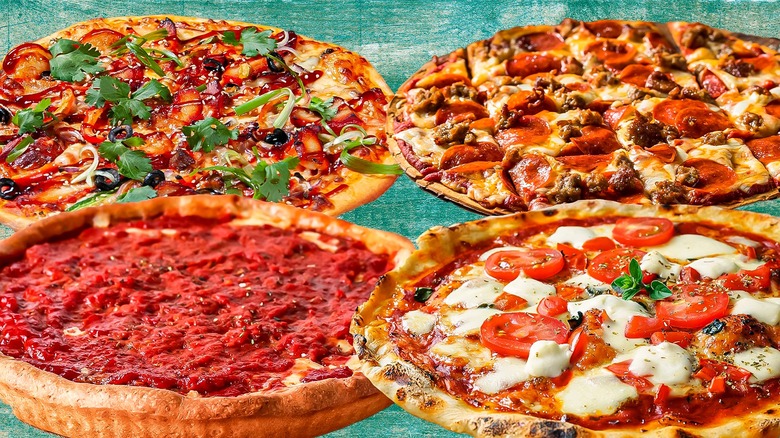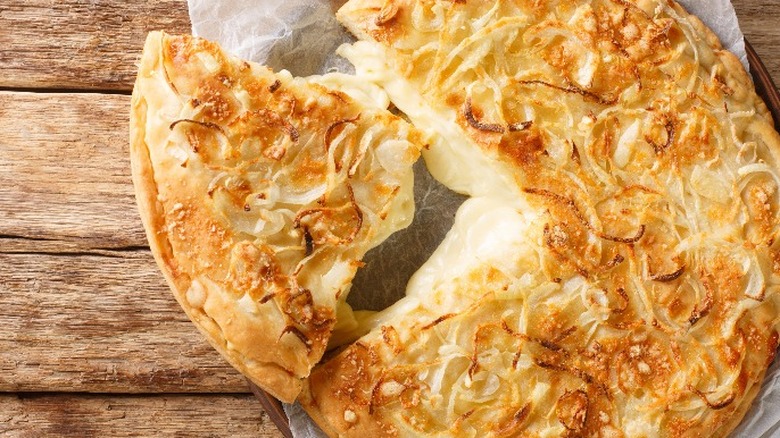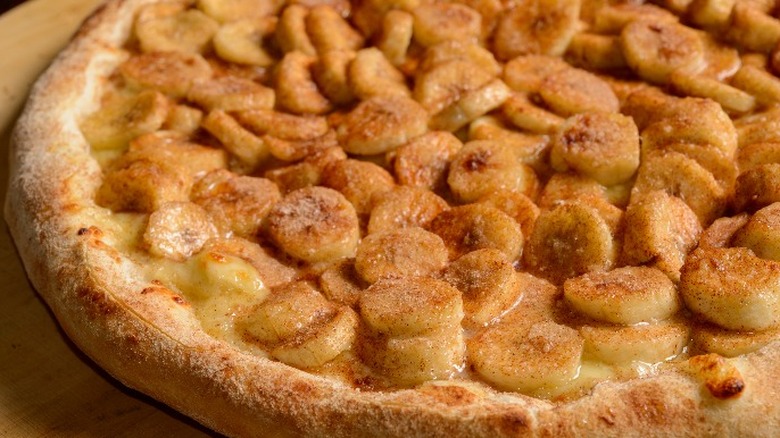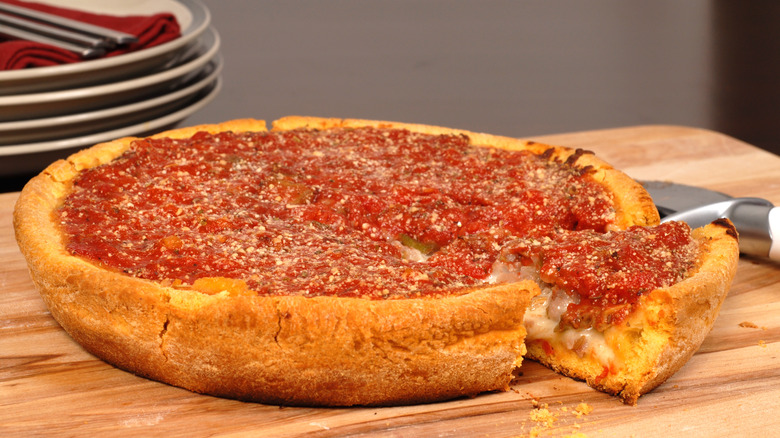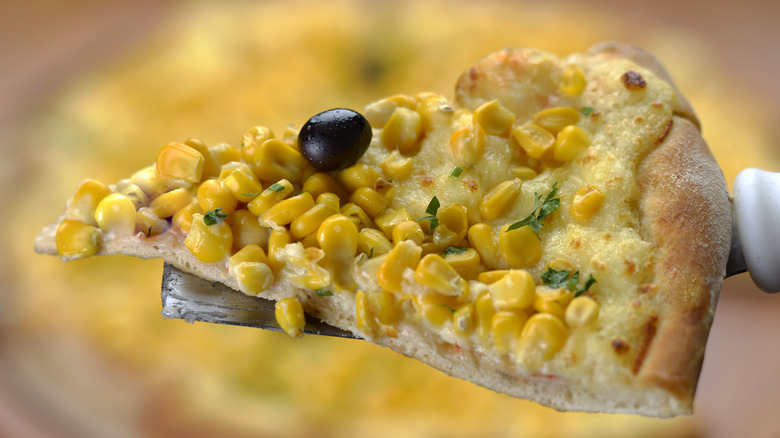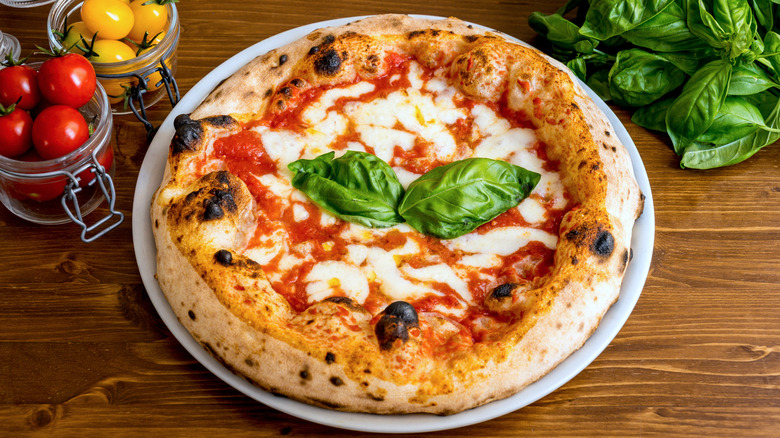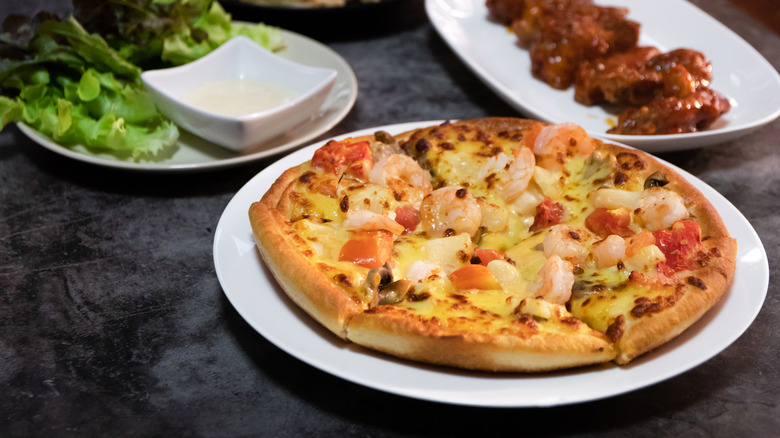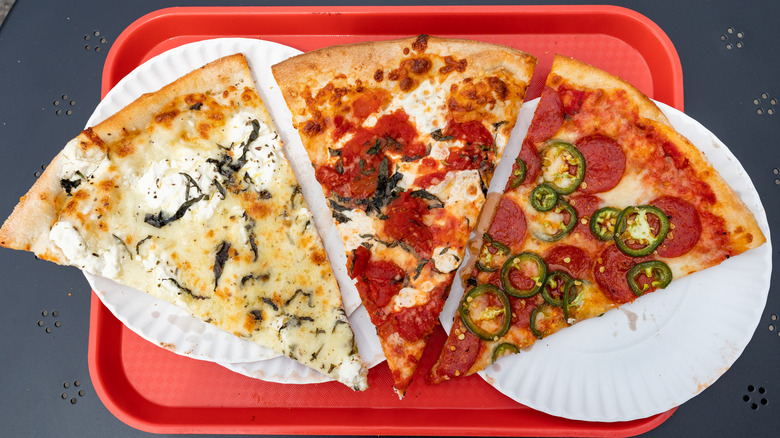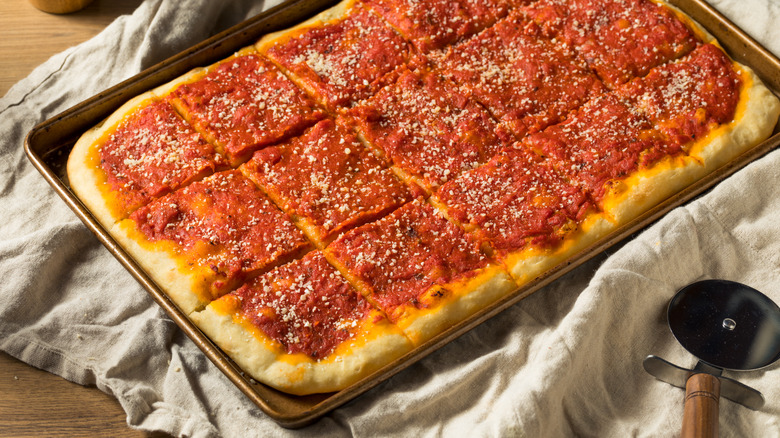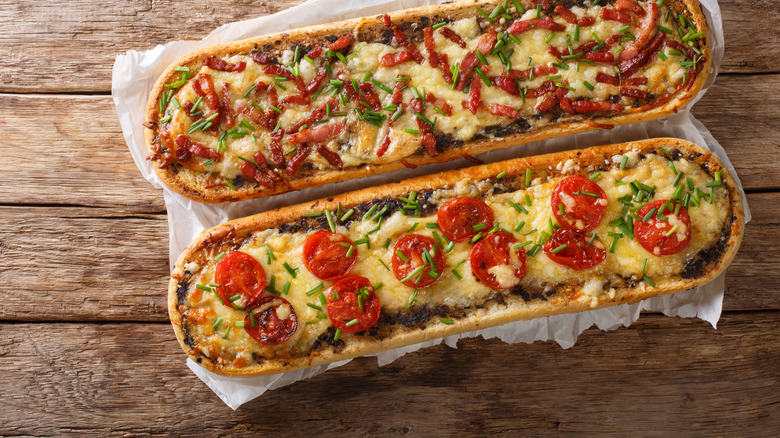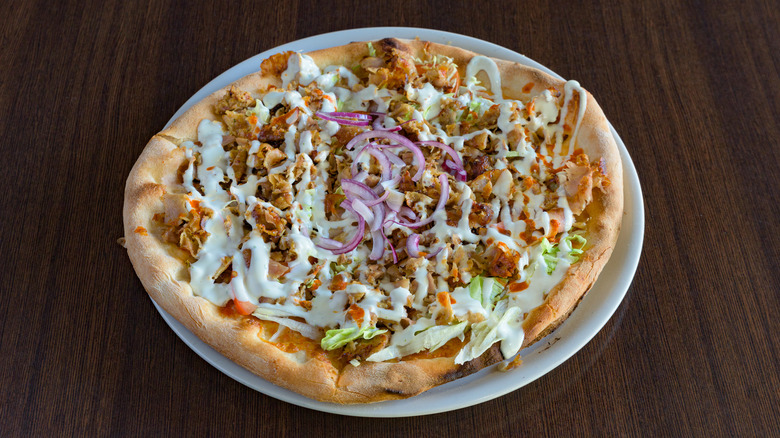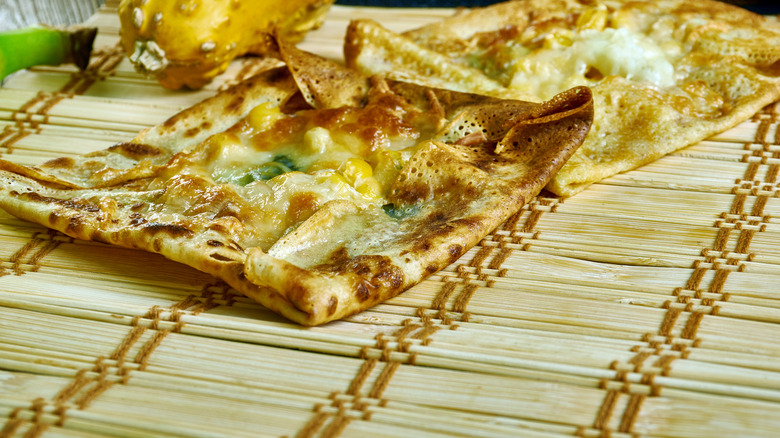12 Ways Pizza Is Made Around The World
What constitutes pizza? While most of us would say dough, tomato sauce, and cheese, the truth is there are many more styles out there. Some pizzas don't have sauce or cheese at all, while others have an extra dose of each. Whatever the pie is made of, there's always a base holding it all together. Because it seems where there's flour and water, pizza naturally follows. And wherever you go, you're bound to find this beloved dish.
That said, don't expect pizza to be the same across different countries or even cities. People have found unique ways to make this classic Italian fare their own, customizing it to their culture and taste preferences. Just think of a typical pizza night where you're from. Do you pick it up by hand, or reach for the knife and fork? Would you consider toppings such as crab meat, banana, or chocolate normal?
What might seem outlandish to some is perfectly commonplace elsewhere — because how pizza is prepared, served, and consumed varies greatly depending on geographic location. So if you're curious about the wide world of pizza, keep reading! We'll explore 12 ways pizza is made around the globe, from its roots in Italy to America and beyond.
1. Argentina
In the late 19th century, a massive wave of Italian immigrants moved to Argentina, bringing their pizza-making traditions with them. These newcomers began selling slices of pie anywhere they could, including street corners and stadiums, until demand led to the creation of full-blown pizzerias. Over time, pizza became a main staple of the local cuisine. But as the decades passed, the Argentinian version diverted from its predecessor and evolved into its own national dish.
Just as Argentinians are proud of their Italian heritage, they're equally proud of their pizza. In Argentina, particularly Buenos Aires, the crust sets this pie apart. The focaccia-like bread rises to almost an inch when baked. And because many pizzas are baked al molde (in a pan), the result is a crunchy bottom with a spongy top layer. And covering the bread is another defining quality of Argentina's pies: an abundance of cheese.
What toppings can you expect in this country? The popular fugazza pizza is layered with sweet sautéed onions, a sprinkle of oregano, and sometimes mozzarella. Its more intense cousin, the fugazzeta, is a double-crusted version stuffed with extra cheese and topped with onions. Other popular pizza add-ons include ham and red bell pepper or napolitana. But unlike the Italian version, Argentina's napolitana has a hearty helping of cheese, fresh tomatoes, garlic, oregano, and whole green olives. In Buenos Aires, you can also find pizza served alongside faina, starchy slices made of chickpea dough.
2. Brazil
At the turn of the 20th century, Italian immigrants didn't just head to Argentina; they made their way to its neighbor, Brazil too. Soon enough, Italian food became wildly popular here, and just like everywhere else, pizza took on a life of its own in Brazil.
Pizza menus in this country are surprisingly diverse, but pies always come with a thin crust. If Brazilians had to pick one pizza they call their own, it would be pizza à Portuguesa. This pizza can have ham, sausage, bell peppers, tomato slices, black olives, onion, peas and corn, and hard-boiled eggs. Adding to the vast array of typical pizza toppings in Brazil are also palm hearts, Catupiry (local cream cheese), or mashed potatoes. And despite having a thin crust, the edge can be filled with cheeses such as a local favorite, requeijão.
Brazilians aren't afraid to embrace their sweet tooth by combining sugary and salty flavors. Dessert pizzas could take up a whole page, with favorite toppings including Nutella, bananas, strawberries, and condensed milk. Those who can't decide between sweet or savory get their pizzas half and half. But regardless of whether it's dinner, dessert, or both, Brazilians eat their pizza with a knife and fork.
3. Chicago
One of Chicago's culinary claims to fame is its deep-dish pizza. As the name suggests, it resembles more of a large pot pie than an actual pizza. Baked in a tall cake pan, they have a high, buttery crust, and with almost an extra inch of height, there's loads of space for sauce and goodies. But to add to the uniqueness of Chicago's deep-dish pizzas, the toppings are in a completely different order than you'd expect. First comes the cheese, followed by veggies, meat, and the like. To top it all off, you have a hearty slathering of chunky tomato sauce.
The result is a super thick pizza that feels just as heavy in your stomach as it does in your hand. Picking up a slice can feel like holding an entire brick, which is why a fork and knife is the preferred method to eat this meal. An entire pie is meant to be shared and not considered an everyday indulgence. Locals would likely agree; as one Reddit user explains, "90 percent of Chicagoans [would say] 'It's good, but it's too heavy to eat often. I usually just eat it when people are in from out of town.'"
4. China
Rumor has it pizza actually originated in China. As the story goes, Marco Polo discovered China's scallion pancakes on one of his 13th-century expeditions. Returning to Italy inspired and craving this tasty dish, he encouraged a chef to recreate it using local ingredients, but with the veggies on top. This narrative has been passed down by retellings, and although there's no solid proof to back it up, it's an interesting theory. Despite historical influences, most people credit Italy with the invention of the now-ubiquitous dish.
Even the Chinese consider pizza a Western food, and it's revered as more of a foreign delicacy than a fast-food item. China's Pizza Hut is a prime example of this. It has a comparatively higher price point and a much classier dining experience. The chain's sit-down restaurants offer fancy appetizers, soups, pasta, and wine.
And without a strong preconceived idea of how American pizza should be, Pizza Hut can get creative and tailor its flavors to the Chinese palate. Would you try its Crayfish Delight pizza with seafood, pepper, and peaches? How about the durian fruit pizza? At one point, this was the hot new topping in China and perhaps also the world's stinkiest pizza. But don't knock it till you try it. This chain is doing something right and is one of the top Western restaurants in China, with over 2,000 branches as of 2020 (per Yum China).
5. Israel
Pizza is a big part of Israel's international culinary scene. You can find various styles, most commonly Italian and New York. In Tel Aviv, La Tigre offers authentic Italian pizza made by chefs trained in Naples, while Brooklyn Pizza sells New York's classic foldable slices.
While neither of these restaurants follows kashrut (Jewish dietary laws), kosher pizza joints exist throughout the country. According to a 2021 article in Yeah That's Kosher, the American chain Papa John's opened its first kosher branch in Petach Tikva. Here, you can expect all the ingredients and cooking methods to follow kashrut, from the crust to the cheese to the toppings. You won't find pork on the menu, so you can forget that sausage or pepperoni. And since cheese and meat aren't consumed together, don't expect beef, either.
However, you will see anchovies, tuna, bulgarit (local feta cheese), or hard-boiled eggs. Kosher pizza restaurants also tend to have more plant-based options like mushrooms, onions, and olives. And due to the local love of corn, you can get these tasty kernels sprinkled over your pie at almost every pizza place.
6. Italy
Naples is widely considered the birthplace of pizza, and locals treat their cuisine like a well-curated art. To be regarded as a Neopolitan pizza, it must follow the region's culinary traditions. According to The True Neopolitan Pizza Association regulations, Naples-style pizzas are made in small circular servings with a maximum diameter of roughly 12.5 inches and a thickness of 0.12 inches. When all the ingredients and toppings are set, they are baked in a wood-fired stone oven for 60-90 seconds. Due to the high heat and quick cooking method, the pizzas end with a raised, airy crust that's soft to the touch and never burned.
These pies are light and simple yet super flavorful. One of the most favored pizza varieties is margherita, which comes with tomato, mozzarella, basil, and olive oil. Another top contender, marinara, has tomato, oregano, olive oil, and garlic. You'll also find artichokes, eggplant, burrata, and prosciutto on your Italian pies. In restaurants, they're served fresh from the oven and aren't pre-sliced. One pie is meant for the individual and is a fork-and-knife affair. If you prefer your pizza to-go, ask for it "al-taglio" to get scissor-cut slices.
When people think of Italian pizza, they generally imagine these Naples-style pies. However, Italy has several other types of pizza that don't get the credit they deserve abroad. Sficione, or "thick sponge" in Italian, hails from Sicily and is made on a rectangular, focaccia-like bread. On the other end of the spectrum, you have Roman pizza with a super thin, cracker-like crust and toppings extending to the very edge.
7. Korea
Koreans have a pension for Western fast food, including pizza — but aren't afraid to add their own flair to the pies. To an American, these pizzas might taste more sweet than salty, with toppings more wild than their Western counterparts. These funky flavors might raise some eyebrows in the States, but they've stood the test of time within the country.
One chain, Mr. Pizza, is somewhat of an institution in South Korea. Its Seafood Island pie combines squid, shrimp, and coconut prawns. But why stop there? The restaurant offers stuffed crust options including cream cheese, mashed sweet potatoes, or eggtart. Domino's in Korea also offers creative combos such as a Crab and Rib House, putting surf and turf right on top of a cheesy pie. More classic Korean toppings include thick potato wedges, sweet mustard, and bulgogi (local marinated meat).
In Korea, pizza joints also serve their pies with pickles. Why, you might ask? As Korean American blogger describes, "Koreans have a hard time with cheese and butter and other rich Western foods. It goes down better for us when there's something to cut through the richness. My parents and grandmother used to come home and eat kimchi after a pasta or pizza dinner out. So the pizza companies give out the pickles for this purpose" (Via Kimchimamas). So if you're going for Korean-style pizza, grab a topping-laden pie and finish your meal with some pungent pickles.
8. New York
New York pizza spawned from Neapolitan pizza brought over by immigrants. When these newly relocated Italians couldn't find the traditional wood-fired stone ovens used back home, they improvised with coal-burning bread ovens. But as the heating source changed from coal to gas, New York pizzas changed as well. Gone were the days of extremely high-heat ovens and fast cooking of individually-sized pies. Locals needed pizzas that could withstand longer cooking times at lower temperatures.
They adapted by adding oil and occasionally even sugar to the pizza dough. These ingredients give New York-style pizza dough its characteristic light and airy texture. Longer cooking times also meant chefs couldn't churn out single-sized pies and still turn a profit. To satisfy the appetites of the masses, New York pizzerias began baking bigger, thicker pies and selling them by the slice.
The result of all these changes: A pie that is heavy on tomato sauce, cheese, and toppings. The crust is thin and crispy but still pliable enough to fold. And because New York slices are characteristically wide, folding them ensures more stability in the eating process. All the goodies will likely end up in your stomach rather than on the sidewalk — or your shirt. Plus, eating pizza the New York way means each bite has a double dose of toppings. One might say New York's pizza adapted to the culture where it exists: independent, practical, and constantly on the go.
9. Philadelphia
Being home to many Italian immigrants, you'll naturally find Naples or Roman-style pizzas in Philadelphia. However, a couple of non-pretentious pies have their roots in the city itself.
A Philly favorite, the pizzazz pizza has a sauceless base topped with American cheese, banana peppers, and fresh tomato slices. There's nothing more American than putting American cheese on a pizza, and it's no surprise that this grilled cheese-meets-pizza creation was born out of childhood nostalgia. According to Billy Penn, two brothers in The City of Brotherly Love came up with the brilliant idea while running the family's pizza shop. Staff members quickly grew to love the pizzazz pizza, and once they put it on the menu, it became a little slice of local history.
Another Philadelphia staple is tomato pie. Although influenced by Sicilian-style pizza, we'd consider it pizza's cousin rather than immediate family. Tomato pie comes on a thick, rectangular loaf with a focaccia-like texture. It's dressed with a red tomato sauce and perhaps a sprinkling of Parmesan cheese (if any at all). Tomato pie is served in square slices and often at room temperature. While it might be a simple dish, it holds a special place in Philadelphia's culinary history. So if you find yourself in the Italian neighborhood of South Philly, try a piece. But whatever you do, don't refer to it as pizza out loud.
10. Poland
Zapiekanka is an open-faced pizza-esque sandwich and one of Poland's most famous street foods. If you want to find the best zapiekanka in town, head where the locals are. However, you don't need to fly that far just to enjoy one.
Although zapiekanka tastes better hot off a street vendor's stall, it's easy to make at home. Slice a baguette lengthwise, and layer it with sautéed mushrooms and onions and grated cheese. You can get as fancy as you'd like with the add-ons, but zapiekanka tastes just as comforting in its classic form. Make sure to toast it till the cheese is melted and the bread is a crispy, golden brown. Drizzle ketchup and mayo on top, and serve it warm.
This Polish fast-food favorite is just as easy to make as it is to consume. The handheld, portable meal can be eaten just about anywhere, anytime. And after a long night out, zapiekanka is a go-to snack that can satisfy a sudden salty craving.
11. Sweden
Move over meatballs; there's another Swedish food in town. Kebab pizza is a local favorite here, despite being relatively unknown to the greater pizza-eating world. Kebab pizza takes all your favorite doner kebab fillings and plops them straight onto a pie. Essentially, you've got your standard base topped with fefferoni peppers, onions, kebab meat, and kebab sauce. In an even weirder but wonderful combo, some pizza shops offer a Viking kebab pizza. This marrying of Turkish, Italian, and local influences involves folding two sides of the kebab pizza to resemble a Viking ship.
When it comes to pizza, Swedes also go bananas for, well, bananas. It's not uncommon for Swedish pizza parlors to add these sweet slices to Hawaiian pizzas, adding even more fire to the pineapple-on-pizza haters' flame. Another common variety is banana curry pizza. In its simplest form, you've got a thin-crust dough with tomato sauce, shredded cheese, banana slices, and curry powder.
As one can see, Sweden isn't in short supply of creative toppings. Others include meatballs, minced meat, oxfile, seafood, or bearnaise sauce. Almost all pizza is served with a side of garlic sauce and pizzasallad, which is a cabbage slaw eaten as a starter, side, or added to the pizza itself. And for those who can never decide between pizza or a burger, the Swedes see you. The monstrously-sized calskrove consists of a hamburger and fries baked into a calzone.
12. Tanzania
Zanzibar pizza is a far cry from the Italian and American offshoots on this list. However, it's a wildly popular street food on the Tanzanian islands of Zanzibar, and anyone who's visited the region can recount tales of this unique pizza.
So what exactly is Zanzibar pizza? Forget everything you know about the Italian style. Instead, Zanzibar pizza is something of a roti-meets-crepe base loaded with a plethora of goodies. It starts with single-sized chapati dough that's been double-layered for support. The toppings can be just about anything under the sun. Zanzibar is no stranger to foreign influences, and this melting pot of cultures is heavily represented in the mixture of spices, ingredients, and flavors on its pizza. Savory options include everything from cheese and tomatoes to lobster and avocado. On the sweeter side, you'll find bananas, mangos, and even Snickers bars.
Once the goodies are piled high, the edges of the dough are folded over to keep everything securely in place. No ovens are necessary since pies are pan-fried in ghee and made to order. And watching the chefs at work is a treat in itself. So if you find yourself roaming Zanzibar's night markets and inevitably stumble upon a pizza stall, let that imagination go wild. No creative concoction is off the table — or should we say, frying pan.
